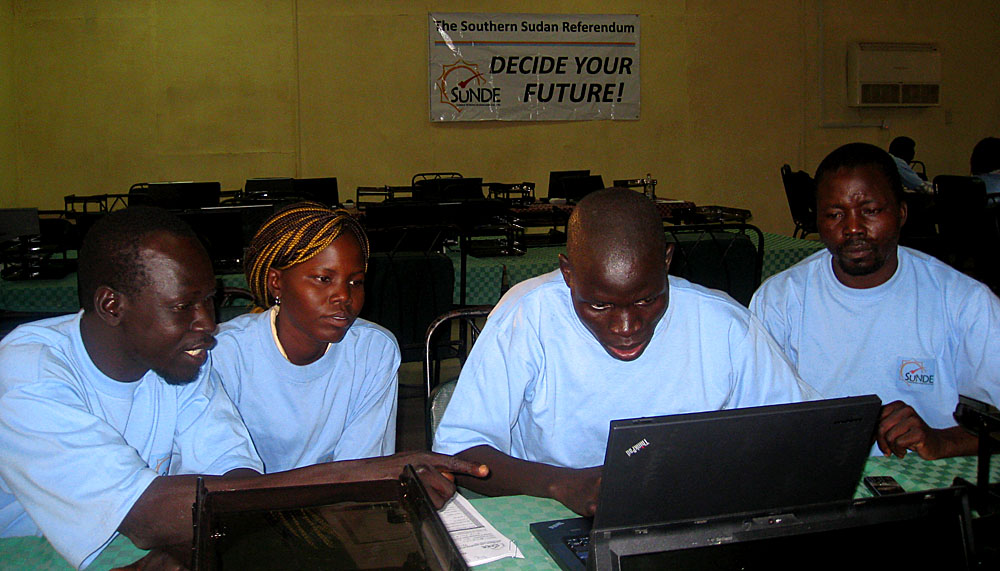Noise to Signal: Southern Sudan Referendum

The final results were announced last week in Southern Sudan’s independence referendum. While voter’s preference was never in doubt (nearly 99% voting for the “open palm”), the results were not officially announced for more than 3 weeks after the last day of voting. In an instantaneous news media culture, which often demands updates on an hourly, or minute-to-minute basis, this delay of information on an electoral process would often mean that audience attention gets diverted, or politically-motivated groups can more easily compete for narrative and truth in a vacuum.
However, those following the referendum closely had an (over?) abundance of options for finding out how the process went. These options reflect how technology is enabling new voices to participate in the process, and how established organizations can reach new audiences. These new tools have their strengths and weaknesses, however together they allow a broad account of an evolving political situation.
This abundance of tools is even more profound given a political and social environment where the majority of the region is inaccessible, the communications infrastructure is weak, and reporting is challenged by divisive politics and years of violence.
Social Media by Journalists and Citizens
Beyond traditional media coverage, characterized by local & international reporters interviewing voters and political leaders (shared through newspaper, radio, television and web), citizens gave voice to their experience and journalists broke their news stories on Twitter and Facebook. Using the hashtag “#SudanRef”, individuals shared their personal experiences and important information quickly in real-time. As with other media, this also meant that premature information from dubious sources spread quickly. For example, conclusions on voter turnout (the most intriguing question of the process) were spread by a party member and became widely accepted as the official position.
Crowd Sourcing by Citizen Reporters
“Crowd-sourced” citizen reports highlight the experience of individual citizens, and are a tool which enables a wider demographic to share electoral incidents. These tools allow individuals to contribute to an understanding of the election; however accuracy and context of the information can be limited, beyond concerns about motivation.
Satellite Images by Violence Monitoring NGOs
George Clooney's “Not On Our Watch” organization, with support from international NGOs and donors, funded the Satellite Sentinel Project, which collected real-time satellite imagery and analyzed it for potential hotspots and threats to security. The first analysis of images corroborated claims by the government on small arms deployment and reports by the UN on military checkpoints. This approach was primarily aimed to be a deterrent, and one inherent weakness was the level of imprecision when trying to assign guilt or innocence to crimes.
Data Analysis by Election Monitors
Trained local and international monitors gather data through direct observation, while employing a range of observation methodologies. Local monitors were deployed region wide, and distributed systematically so as to collect vast quantities of statistical data for analysis. International monitors, without the same statistical data, gathered information and brought international credibility and attention to their observations. Sudanese conclusions on the pre-election period and on voting (International & Sudanese) could be read within days. While this information is often more systematic, the underlying data takes time to process and without strong communication efforts does not reach a wide audience.
Mapping Visualization by Electoral Commission
The official results from the Southern Sudan Referendum Commission were released in a comprehensive and user-friendly way. We’ve blogged previously about an enlightened approach to sharing information as “Open Data”, here and here. Displaying referendum results down to individual polling centers allow individuals to review the results, as well as download and run their own analysis. While it took weeks to collect and compile this data, its use as a forensic and post-event analytic is invaluable.
Conclusion
The growth of tools for data collection, analysis, sharing and visualization, profoundly seen here in a resource-poor environment, increases the amount, potential quality, and contextualization of information around a critical political event, while also allowing greater participation from a variety of actors. As always, there will be a competition for access to “the truth” and challenges in credibility for all messages. An assessment of methodology and motivation will continue to help audiences decipher which medium and source is most valuable at a given time.
